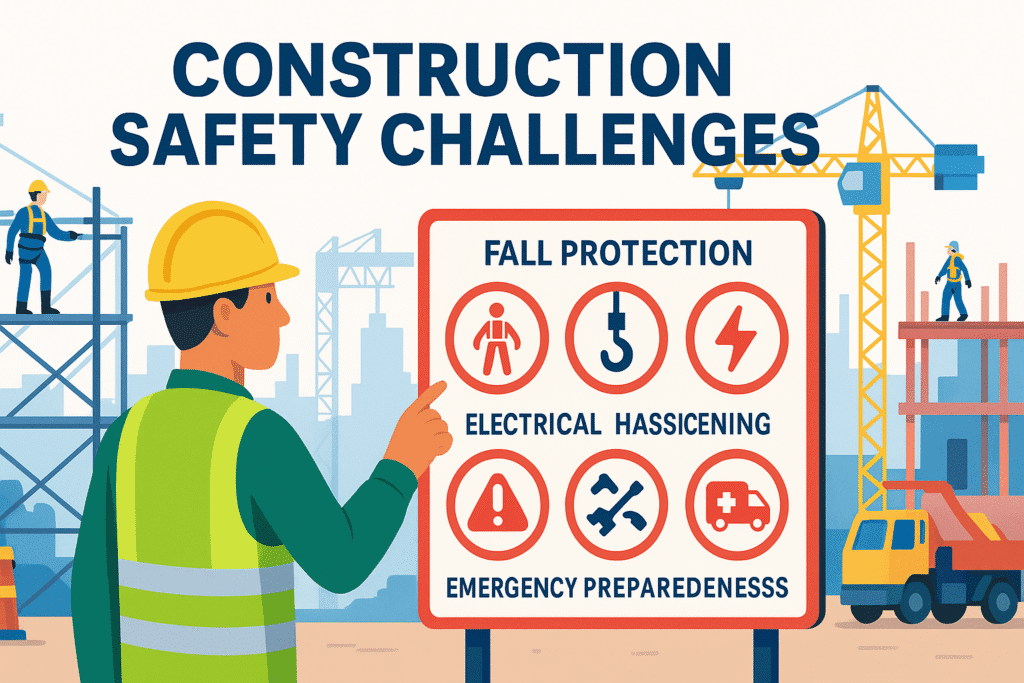
Construction Safety Challenges: Hazards, Controls & Best Practices
The construction industry is one of the most hazardous sectors worldwide, employing millions of workers in diverse, dynamic environments. With constantly changing job sites, heavy machinery, high-risk tasks, and multiple contractors, ensuring safety can be a complex challenge. This article explores the key safety challenges in construction, why they persist, and how to mitigate them effectively.
Major Construction Safety Challenges
1. Working at Heights
- Falls from scaffolds, ladders, and roofs are the leading cause of fatalities.
- Inadequate fall protection, poor scaffolding, or untrained workers increase risk.
- Requires proper fall arrest systems, guardrails, and competent supervision.
2. Struck-By and Caught-In/Between Incidents
- Workers face hazards from moving vehicles, falling objects, or collapsing structures.
- Excavations, cranes, and heavy equipment present pinch points and impact zones.
- Use exclusion zones, spotters, and PPE to minimize risk.
3. Electrical Hazards
- Temporary wiring, overhead power lines, and improperly grounded tools can cause shocks or electrocutions.
- Requires lockout/tagout, GFCIs, and inspection of equipment.
4. Poor Housekeeping
- Debris, tools, and materials cluttering walkways create trip hazards.
- Good housekeeping is a fundamental yet often neglected control.
5. Unsafe Lifting and Manual Handling
- Frequent lifting of heavy materials leads to musculoskeletal injuries.
- Use mechanical aids and teach proper lifting techniques.
6. Dynamic and Changing Work Environments
- New hazards emerge as construction phases progress.
- Constant re-evaluation of risks is necessary.
7. Contractor and Subcontractor Coordination
- Multiple contractors with different safety cultures work on the same site.
- Requires clear communication, uniform safety standards, and coordinated toolbox talks.
8. Weather and Environmental Conditions
- Heat stress, cold stress, rain, or high winds affect safety.
- Seasonal hazards must be addressed proactively.
9. Language and Cultural Barriers
- Multilingual and diverse workforces can lead to communication breakdowns.
- Use visual signage, multilingual training, and safety champions.
10. Emergency Preparedness
- Construction sites often lack permanent infrastructure, making evacuation or rescue more difficult.
- Emergency plans must be adapted to each phase of work.
Control Measures and Best Practices
- Comprehensive Risk Assessments: Update frequently as work evolves.
- Training and Competency Assurance: Inductions, refreshers, and verification of skills.
- Permit-to-Work Systems: For hot work, confined spaces, lifting operations.
- Fall Protection Programs: Guardrails, safety nets, personal fall arrest systems.
- Equipment Inspections: Regular checks of cranes, scaffolds, tools.
- Behavior-Based Safety Programs: Encourage safe behaviors and reporting of near misses.
- Contractor Safety Management: Prequalification, common standards, and shared toolbox talks.
- Emergency Response Planning: On-site first aid, rescue equipment, and coordination with local responders.
Common Pitfalls
- Overlooking risks in early planning stages.
- Inconsistent enforcement of safety standards across subcontractors.
- Treating safety as a compliance checkbox rather than a core value.
- Lack of follow-up on near misses or unsafe observations.
Example Scenario
During a high-rise project, scaffolding collapses due to improper erection and overloading. Workers are injured, and work halts for weeks. A proper scaffold inspection program, competent personnel, and adherence to manufacturer guidelines could have prevented the collapse.
Conclusion
Construction safety challenges stem from dynamic environments, multiple stakeholders, and high-risk tasks. By proactively managing hazards, ensuring worker competence, and fostering a safety-first culture, construction projects can significantly reduce incidents and protect their most valuable asset—people.
External Link: OSHA Construction Industry Standards (https://www.osha.gov/construction)
Oil & Gas / Petrochemical Safety Challenges: Hazards, Controls & Best Practices
Refreshing Safety Talks: Using Stories and Near Misses to Teach
How to Keep Safety Training Engaging in Remote or Hybrid Setups
Top 12 Toolbox Talk Topics for This Month/Season
Slips, Trips & Falls Prevention Toolbox Talk
Exam-Oriented Practice Questions with Answers
Short Answer Questions
- Name the leading cause of fatalities in construction.
Answer: Falls from heights. - List two control measures to prevent struck-by incidents on construction sites.
Answer: Establish exclusion zones and use spotters or signalers around moving equipment. - Why are dynamic work environments a challenge for construction safety?
Answer: Hazards change frequently as the project progresses, requiring constant reassessment.
Long Answer Questions
- Explain the major safety challenges faced in the construction industry.
Answer: Hazards include working at heights, struck-by/caught-in incidents, electrical hazards, poor housekeeping, manual handling injuries, changing environments, contractor coordination, weather, language barriers, and emergency preparedness challenges. - Discuss how contractor and subcontractor coordination can improve safety on construction sites.
Answer: By establishing uniform safety standards, clear communication, joint toolbox talks, and shared risk assessments, inconsistencies are reduced and everyone understands expectations. - Describe control measures to address fall hazards in construction.
Answer: Use guardrails, scaffolds erected by competent personnel, safety nets, personal fall arrest systems, training, and routine inspections.
Scenario-Based Questions
- A construction worker receives an electric shock from temporary wiring. What immediate and long-term actions should be taken?
Answer: Provide first aid and medical attention, secure the area, investigate the incident, inspect all temporary wiring, and reinforce electrical safety training. - Multiple subcontractors are working on your site, but safety practices vary widely. How do you address this?
Answer: Implement a unified safety orientation, conduct joint toolbox talks, and enforce the same safety standards for all contractors. - Heavy winds are forecast during crane operations. What’s your decision?
Answer: Suspend crane operations until conditions are safe, secure materials, communicate with crews, and follow manufacturer’s wind speed guidelines.






















